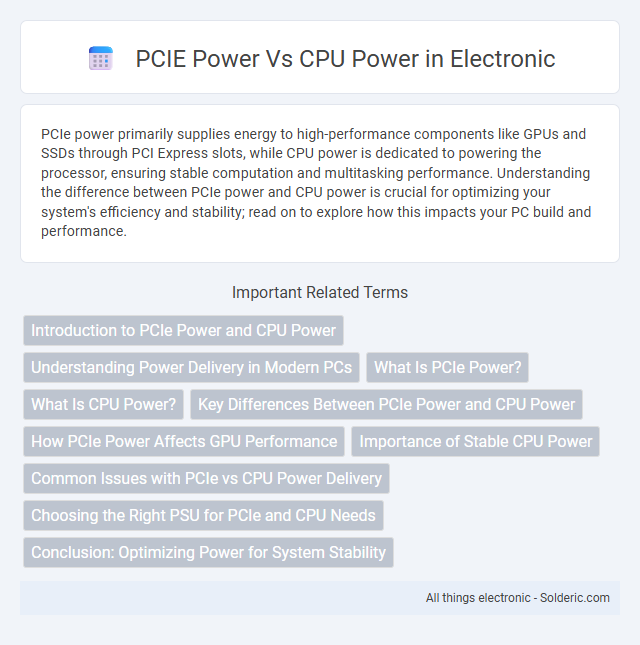PCIe power primarily supplies energy to high-performance components like GPUs and SSDs through PCI Express slots, while CPU power is dedicated to powering the processor, ensuring stable computation and multitasking performance. Understanding the difference between PCIe power and CPU power is crucial for optimizing your system's efficiency and stability; read on to explore how this impacts your PC build and performance.
Comparison Table
| Power Type | Source | Typical Power Range | Purpose | Connector Types | Key Notes |
|---|---|---|---|---|---|
| PCIe Power | Motherboard / PSU via PCIe slots and additional PCIe power cables | Up to 75W via slot, +75W to 150W+ via auxiliary 6/8-pin connectors | Powering graphics cards, high-performance expansion cards | 6-pin, 8-pin (6+2), 12-pin connectors | Supports high power GPUs beyond motherboard slot limit |
| CPU Power | Motherboard via 4-pin/8-pin EPS connectors from PSU | Typically 65W to 150W+ depending on CPU and motherboard design | Powering the central processing unit | 4-pin, 8-pin EPS connectors | Dedicated stable power rail for CPU performance and stability |
Introduction to PCIe Power and CPU Power
PCIe power refers to the electrical power supplied through the PCI Express slot, primarily used to power expansion cards such as GPUs and SSDs, with a standard PCIe slot delivering up to 75 watts. CPU power, on the other hand, is the electrical power that the CPU requires to operate, typically supplied through dedicated power connectors from the power supply unit, with current CPUs consuming anywhere from 65 to over 150 watts depending on the model and workload. Understanding the differences between PCIe power and CPU power is essential for optimizing system power delivery and ensuring stable performance.
Understanding Power Delivery in Modern PCs
PCIe power delivery supplements the CPU power to efficiently support high-performance components such as GPUs and NVMe SSDs in modern PCs. The CPU power primarily supplies energy to the processor cores, while PCIe power connectors provide additional wattage directly to expansion cards, ensuring stable operation under heavy loads. Efficient power management between PCIe and CPU power rails is crucial for maintaining system stability and maximizing performance in gaming and professional workstations.
What Is PCIe Power?
PCIe power refers to the electrical energy delivered through the PCI Express (Peripheral Component Interconnect Express) interface, which supplies power to expansion cards like GPUs and NVMe SSDs directly via the motherboard's PCIe slots. Typically, a PCIe slot provides up to 75 watts, with additional power connectors supplementing high-performance devices requiring more electricity. Unlike CPU power, which primarily drives the processor's operations, PCIe power specifically supports peripheral components, ensuring efficient data transfer and functionality within the system.
What Is CPU Power?
CPU power refers to the electrical energy supplied directly to the central processing unit (CPU) on a motherboard, typically measured in watts. It is delivered through dedicated CPU power connectors, such as the 4-pin, 8-pin, or 8+4-pin EPS connectors, ensuring stable and sufficient voltage for processor operation. Accurate CPU power delivery is crucial for system stability, performance, and efficient overclocking, distinguishing it from PCIe power, which primarily supports peripherals like graphics cards.
Key Differences Between PCIe Power and CPU Power
PCIe power primarily supplies energy to graphics cards and expansion cards via the PCI Express slot, delivering dedicated 12V power connectors specifically designed for high current loads. CPU power, conversely, is routed through the motherboard's 8-pin or 4-pin EPS connectors, providing stable power to the processor to maintain optimal performance and stability under varying workloads. Understanding the distinction in voltage delivery, connector type, and targeted hardware ensures efficient power management and prevents potential damage to components.
How PCIe Power Affects GPU Performance
PCIe power directly influences GPU performance by ensuring stable and sufficient energy delivery for high-demand graphics processing tasks. Insufficient PCIe power can cause throttling or instability, limiting your GPU's ability to reach maximum clock speeds and rendering performance. Optimizing PCIe power helps maintain consistent frame rates and smooth gameplay in graphic-intensive applications.
Importance of Stable CPU Power
Stable CPU power is critical for maintaining optimal system performance and preventing crashes or data corruption during intensive tasks. Unlike PCIe power, which primarily supplies add-on cards like GPUs and storage devices, CPU power demands precision voltage regulation to ensure consistent processing speeds and reliability. Your computer's overall stability depends heavily on a reliable CPU power delivery system to support multitasking and high-frequency operations.
Common Issues with PCIe vs CPU Power Delivery
Common issues with PCIe vs CPU power delivery often stem from insufficient or unstable voltage supply, leading to system crashes and degraded performance during high workloads. Overloaded PCIe lanes can cause power throttling, affecting your GPU or NVMe device efficiency, while CPU power delivery problems may result in thermal throttling or unexpected shutdowns due to inadequate current or voltage regulation. Monitoring power phases and ensuring quality power connectors can mitigate these risks and maintain optimal hardware stability.
Choosing the Right PSU for PCIe and CPU Needs
Selecting the right PSU for PCIe and CPU power involves understanding their distinct wattage and voltage demands, ensuring the supply meets peak load requirements for both components. PCIe devices often require 12V rails with specific amperage to support GPUs and expansion cards, while CPUs demand stable power delivery through dedicated 12V CPU connectors for consistent performance. A high-quality PSU with sufficient wattage headroom and multiple rails or a single strong rail design provides optimal efficiency and system stability, preventing power bottlenecks during intensive workloads.
Conclusion: Optimizing Power for System Stability
Balancing PCIe power and CPU power is critical for system stability, as insufficient power delivery can lead to component throttling or failures. Efficient power management ensures the CPU receives a consistent voltage supply while PCIe devices, such as GPUs and SSDs, have adequate power for peak performance. Optimizing power distribution reduces thermal stress and enhances system reliability during intensive workloads.
PCIE Power vs CPU Power Infographic

 solderic.com
solderic.com